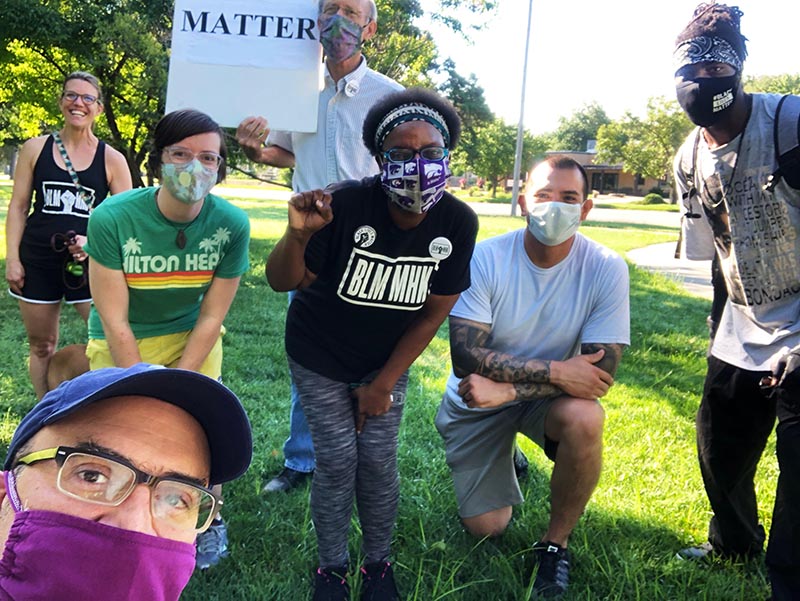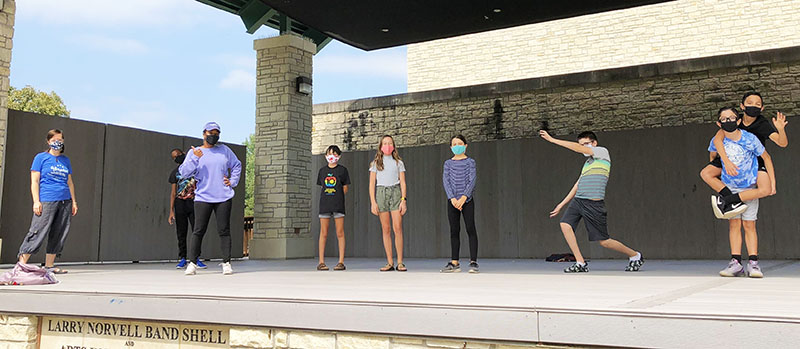



On Saturday mornings runners from Manhattan, Kansas gather together at City Park to start their day with prayers, a 2.23-mile run, and conversations relating to racism and what constructive action might be taken to heal it for the next generation.
Since February 2020, Bruce Grover, a Bahá’í, has felt deeply impacted by the fatal shooting of Ahmaud Arbery that took place in Georgia. He began running 2.23 miles, symbolic of that tragic day February 23.
During his runs, he prays, meditates and reflects on what he could do to address racism in his own life and the community. “I thought to myself, wouldn’t it be nice to have a few friends come and run with me and we could start to have some conversations around this?” Grover says.
He then reached out via his social media to share this activity he calls “Pray/Run/Talk.”


People from all walks of life have joined in, and every Saturday, 10 to 20 adults, youth, and children show up ready to run and share prayers centered around justice, unity and change. “It’s essentially a devotional gathering,” Grover says.
Justin Avalos, another Bahá’í who takes part, says that the group offers a wide variety of prayers, and people share what is on their hearts. Safety precautions include masks, social distancing, and sanitizing.
While running, Avalos says, he reflects on having the courage and wisdom in daily life “to stand up against racism and to speak up.”
After they run/walk together, the participants rest and talk beneath the shade of a towering oak tree in City Park.
Grover plans the gatherings to be places “where there is safe sharing and where people don’t interrupt each other, where people don’t start preaching, or bring in their agenda in an inappropriate way.” He says they are creating a space “where a dialogue can happen and people can share really authentically.”
One participant shared her pleasure that she “can come here and just pray and trust that there is going to be a conversation that is not going to be politicized.” There is space for people to begin to bridge a multitude of differences.
Avalos says, “Having the opportunity to be in this space with complete strangers and being able to talk about spiritual principles and things that matter, things that are deep, and things that affect us on a spiritual level — is huge. At the very beginning there was a lot of energy and tension and to have that open space was really therapeutic for so many people, me included,” he says.
“As people began to share their thoughts, a couple key themes have emerged,” says Grover.
For example:
Local news has featured this initiative.
Grover’s children have also been inspired by this initiative. Bahiyyih, 11, says, “I think it’s really powerful … to hear what goes through people’s minds. One lady said that as she was running she was looking down at her hands, and she said ‘with these white hands I’ve done so many things but what if they were a different color? Could I have done all those same things?’”
Regarding racism, Bahiyyih, says that “it’s a lot easier to make friendships if you know about the person. It’s easier to solve things when you’re all friends and you’re all working together.”
Bahiyyih was inspired to write to her local school board asking that they consider offering a more racially just curriculum. Her brother Olinga, 8, says he has begun giving money to causes that help people in need around the world.


As the weeks went on, how to move beyond words and into ‘constructive action’ remained a consistent topic of conversation. Grover says that “Some came ready to make change now and others were unsure of what to do but wanted to raise their kids differently. Others had family members who were racist, openly or unconsciously, and came just for support.”
Several families who participated in “Pray/Run/Talk” were soon invited to bring their young ones to start a Bahá’í children’s class and a junior youth group. They meet at the same park on Saturdays in the afternoons, a few hours after “Pray/Run/Talk” takes place.
Avalos says, “I connected with Bruce and Kate [Grover, Bruce’s wife] and just started trying to get involved. Me and my wife Toni, we have three little ones, Aden, Alijah and Willow, so education for them and bringing them up with children’s classes and junior youth groups, that was something that was important to both of us.”
Avalos has recognized that “One of the big things that I’ve taken from this whole process is that I also have things from my childhood, my upbringing, my life experiences that I need to identify and work on. That was a huge breakthrough for me.”
“For me…I’m going to break that generational bondage in my own family. It’s a matter of teaching my own children about racism and having those conversations that are so important,” he says.
After nearly a year of gathering, these friends have since embraced a number of collective truths, says Grover. They recognize “the reality that racism exists in America, the awareness that healing comes about through honest dialogue and constructive action, and that humanity actually is one.”


Bahiyyih Grover, 11, who runs alongside her brother Olinga, 8, says that “When I say that I want to take a break, Olinga says to me ‘No no no! You can’t take a break! What we’re doing is important! We have to keep running! We have to keep going!’ and it motivates me, so I try to take some deep breaths and keep going.”
Since participating in the Pray/Run/Talk initiative the children of the Grover family have been inspired to take constructive personal action to advance racial justice in a number of practical ways.
Bahiyyih says, “I try to think about what I can do for our community…what are things that I can do for even just my school to help with the systemic racism that we have? And so over the summer I wrote a letter to the school board saying, ‘I know there’s a lot of stuff going on with COVID right now, but also what are we going to do about this (systemic racism),? This is a really important issue. You know, the curriculums in a lot of schools are often from a colonize[r] perspective, and I want to be able to hear the true history of America.’”
She says she was disappointed when she got a thank you in reply, but no mention of change. “I realized [this was maybe something] that people of color go through all the time.”
Bahiyyih was also invited to attend a school board meeting to talk about her ideas. “Sometimes I feel like, can one person, can one kid, really make that big of a change to what our school board is doing? If lots of people were to do that [take initiative towards racial justice], then we could actually make a change.”
Longing for a community that learns to develop racial justice, Olinga states “My heart would feel awesome! We really need to be racially just because it’s unfair [not to be].”
“We all don’t have to be identical because the whole point is to be diverse,” Bahiyyih adds.
Olinga takes action through giving, “I started to be more generous and sharing the money that I have. I’ve shared to the Bahá’í fund, an orphanage, and families around the world.”
Bruce Grover, their father, says, “All those who join Pray/Run/Talk recognize that racism has affected their lives and that of those around them.” Once conversations got going, “things began to happen. … I then started talking to people about starting a Ruhi Book 1 [study circle].”
Bahiyyih says that those participating in the study circle happen to be a lot of the parents whose kids are now in the children’s class and in the junior youth group all of which have an emphasis on race unity.
“The presence of Bahá’í children who share prayers from memory and their reflections as well, have touched the hearts of the adults, and the Creative Word seems to penetrate the consciousness of participants in profound ways.” says Grover.


![]()
![]()
Whether you are exploring the Bahá'í Faith or looking to become an active member, there are various ways you can connect with our community.
Please ensure that all the Required Fields* are completed before submitting.